
The 17 best experiences on the Amalfi Coast
The Amalfi Coast is the romantic star of many movies and has worked its way from the silver screen into the hearts of travelers worldwide.
A UNESCO World Heritage site, the coast is remarkable for more than just its crystalline sea and culinary delicacies; it’s full of rich history, art, craft, traditions and natural beauty.
Enchanting towns are perched on the rocky Monti Lattari, with others extending to the blue waters of the Tyrrhenian Sea. Towns like Sorrento and Positano are household names, while others with just as much to offer are frequented by those in the know. Here are the top things to do along the Amalfi Coast, traveling from north to south.
1. Photograph an Ancient Roman mill in Sorrento
Like most places in Campania, the town of Sorrento has ancient origins dating back to 800 BCE. It has been a tourist paradise since Roman times, when wealthy nobles would travel from Rome to enjoy Sorrento’s seaside and its local produce, such as wine, olives and citruses. Even Emperor Augustus’ son had a villa here. You can climb atop the ancient walls of Sorrento and pretend you’re scouting the horizon for pirates.
Sorrento also has an original mill from the 13th century, situated in a natural valley that originated 37,000 years ago. The mill is privately owned, and there are talks of renovating it into a visitable touristic sight and reopening the path down the valley. Either way, looking down at the Valley of the Mills as it is from Via Fuorimura retains its own kind of charm. This is perhaps the most haunting abandoned place on the coast and is worth the visit, even from 9m (30ft) above.

2. Crash a wedding in this splendid 13th-century cloister in Sorrento
An average of 500 weddings are celebrated yearly in Sorrento, a town of just 16,000 inhabitants. As you stroll around the town, you will run into at least one wedding ceremony in the Church of St Francis and the adjacent cloister. Built during the 13th century on the ruins of a 7th-century structure, the Chiostro di San Francesco’s Gothic-inspired bare stone walls and double-arched windows incorporate elements from various ages upon closer inspection. Every column has a different capital style crowning its top - a sign that the stone was recycled from a different building. The sunlight hits the pavement through the trees, creating an even more sacred atmosphere.
Many children from the town often sneak into the lavish destination weddings held there daily, probably intrigued by the extravagant hats and dresses of the guests that are so different from the ones they’re used to seeing at Sorrentine celebrations. Take it from a local - it's worth quietly entering the cloister or church as a wedding happens to share in the joy of a happy day in stunning surroundings.
Detour: As you leave, check out the enchanting Villa Comunale right by the cloister. There, surrounded by well-cured vegetation and statues of notable Sorrentine personalities, you have the best view from Sorrento onto the Gulf of Naples, Mt Vesuvius and the surrounding islands. There is even a telescope that you can use to make out the buildings on the other side of the coast.
3. Eat a lemon delice in Sorrento
All food tastes better in Sorrento; maybe it’s the water used to cultivate or wash the produce, or perhaps it’s the salt in the air. Vegetables and fruits from the hills have unique shapes and tastes, like the famous pumpkins and zucchinis that look so incredible that you almost don't want to cut them. The seafood is, of course, a marvel of its own. But the real scene stealers are Sorrento’s lemons and their big brother, the citron (cedro), which can be three or four times the size of a regular lemon.
Sorrento’s typical dessert is called lemon delice (delizia al limone), and, true to its name, it's a real treat for your senses. It has the tart smell of lemons with a delicate and creamy taste. Wash it down with homemade limoncello, which is on the house in most restaurants after a large meal. If you don’t drink alcohol or are lactose intolerant, try a lemon granita or a sorbet instead.
4. Go kayaking to Bagni Regina Giovanna
Bagni Regina Giovanna got its name because it was the favorite bathing spot of Giovanna II of Naples, one of the first queen regents of Europe, in the 14th century. This cove lies between a headland and a natural archway above the water. Today, it’s a highly sought-after destination by tourists and locals for a dip in the clearest water.
The place is part of a natural reserve for its landscape and archaeological beauty; it still houses the ruins of a 1st-century CE Roman villa that belonged to Pollio Felice, Virgil’s mentor. There are no human-made structures, no sunbeds or umbrellas to rent, and no places to buy water or snacks here - bring your own towels and comfortable shoes to walk across the rocks.
To reach Bagni Regina Giovanna, the more tiring option is a half-hour hike down the hill to the strip of beach surrounding the gorge. The easier way to reach the sparkling cove is by water; you can rent a kayak, canoe or pedal boat in Sorrento’s Marina Grande and enter the gorge from the sea, passing underneath the natural archway.
Planning tip: The best time to go is early in the morning. Avoid going on weekends when Regina Giovanna becomes crowded with locals who close up shop to enjoy this magnificent place.
5. Look out on two gulfs from Sant’Agata
The village of Sant’Agata Sui Due Golfi was named for its view overlooking the Gulf of Naples and the Gulf of Salerno. On a sunny day, hike (or drive) up the 300m (984ft) hill once named Monte Sireniano (Mount of the Sirens). The area is the only known place in the Mediterranean to host a temple dedicated to sirens.
Stop by the monastery dedicated to Saints Paul and Agatha. There, on the belvedere, enjoy a spectacular view of the islands of Capri and the smaller, privately-owned Li Galli, as well as the Bay of Naples and the Gulf of Salerno. Time your arrival and watch the sunset on the sea between the strips of land, casting hues of blue, red, purple and orange across the water. The stars seem much closer and shine brighter from here than from the city below.
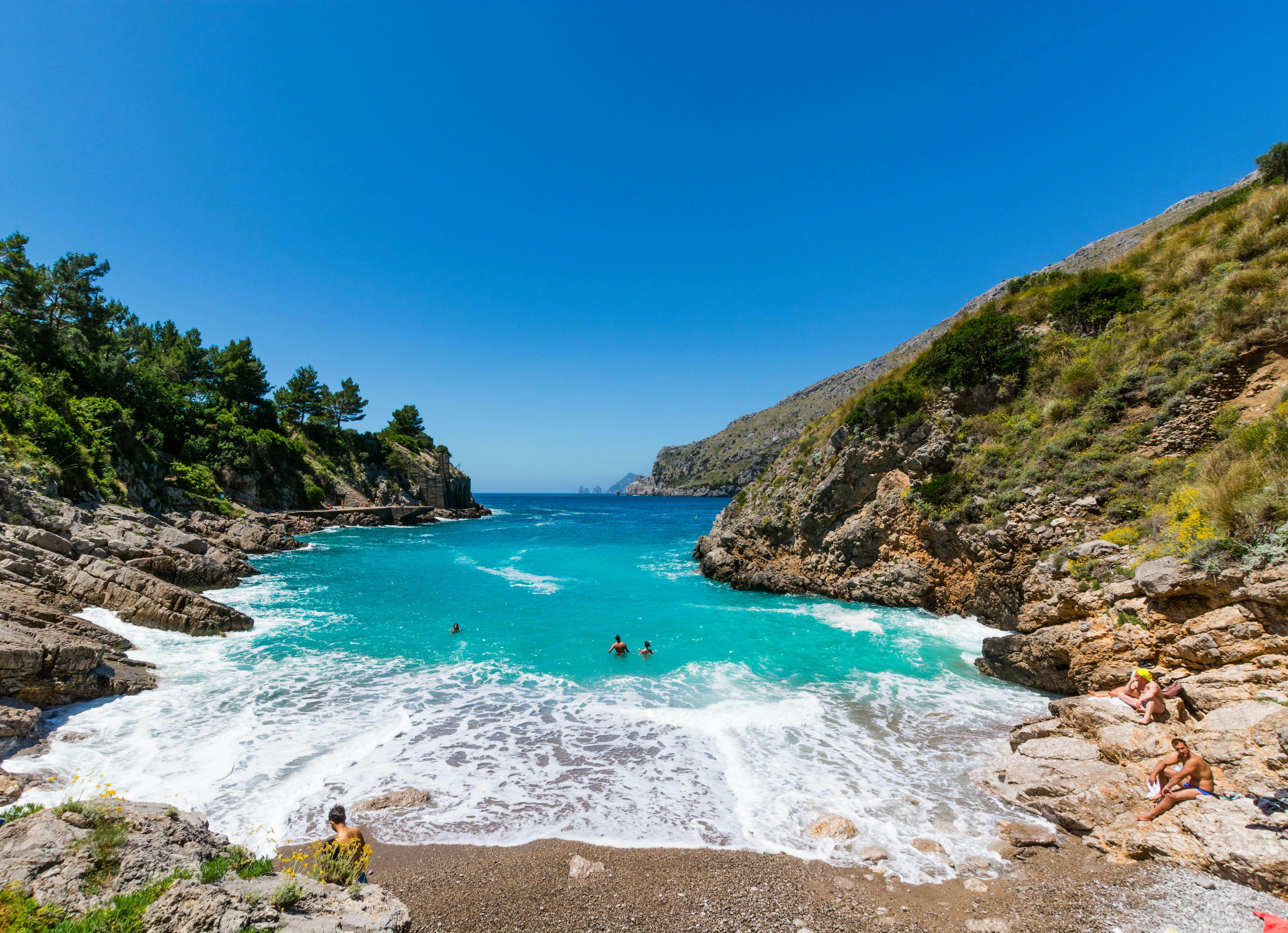
6. Take a dip at Ieranto
There is a place on the coast where the sea is incredibly blue, and the vegetation is protected and allowed to grow freely - Baia di Ieranto. This small bay surrounded by olive trees and Mediterranean scrub belongs to Fondo Ambiente Italiano (FAI), a foundation for safeguarding Italy’s artistic and naturalistic heritage. Far from the nearby towns, this is the cleanest and clearest section of the coast because no engines of any kind are allowed in its proximity. FAI organizes guided tours and cultural events on certain days.
You can take a bus or drive to the village of Nerano, which is part of Massa Lubrense and close to Sorrento. From there, you will need to proceed on foot along the rocky path for an hour (it’s a medium-level hike), so wear comfortable shoes and a backpack, and bring a reusable water bottle. At the end of the path, you will be met with an incredible view over Capri’s Faraglioni, towering rock formations rising up from the sea.
Even in ancient times, Ieranto was known for its beauty. Pliny the Elder claimed it was here that Odysseus met the sirens on his way back to Ithaca. While there are no sirens or mermaids now, the bay is filled with numerous species of fish, unbothered by engines or nets.
Planning tip: There are no facilities here - you might want to bring a snack if you intend to stay awhile. Or you can save your appetite and enjoy the famous spaghetti alla Nerano once you’re back in town: delicious pasta with zucchini, topped with a local cheese called Provolone del Monaco.
7. Sail around Capri and into the Blue Grotto
Another unmissable experience in Capri is a guided boat tour around the island. You will hear fascinating tales, from Homer’s Odyssey to the many celebrities who own incredible villas on the island today, and you'll pass between the iconic Faraglioni, Capri’s most famous landmark. According to the legend, the two rocks were tossed by the cyclops Polyphemus in pursuit of Odysseus, who had cheated him. When sailing through the two rocks, listen to the captain sounding the boat’s horn, and don’t forget to kiss a loved one - legend says it will bring luck and love to you both.
Arguably, the most beautiful place in Capri is the Grotta Azzura (Blue Grotto). People often think pictures of it are edited because the sea water can’t possibly be so blue, but they're wrong. Sunlight passing through an underwater cavity creates the enchanting effect of crystalline blue water. Two thousand years ago, this grotto was Emperor Tiberius’ chosen swimming pool as well as an underwater temple. The statues that were once at the entrance of the grotto are now at the museum in Anacapri.
Once outside the Grotta Azzurra, you will need to hop onto a smaller boat with oars, as engines are not allowed near or inside the cave. Note that the grotto can sometimes be closed due to weather conditions, so always check with the staff at Marina Grande before purchasing a boat tour. Inside the grotto, swimming or diving is forbidden, but just admiring the colors inside is a magical experience.
Planning tip: The best time to visit is when the water is at its brightest, between noon and 2pm.
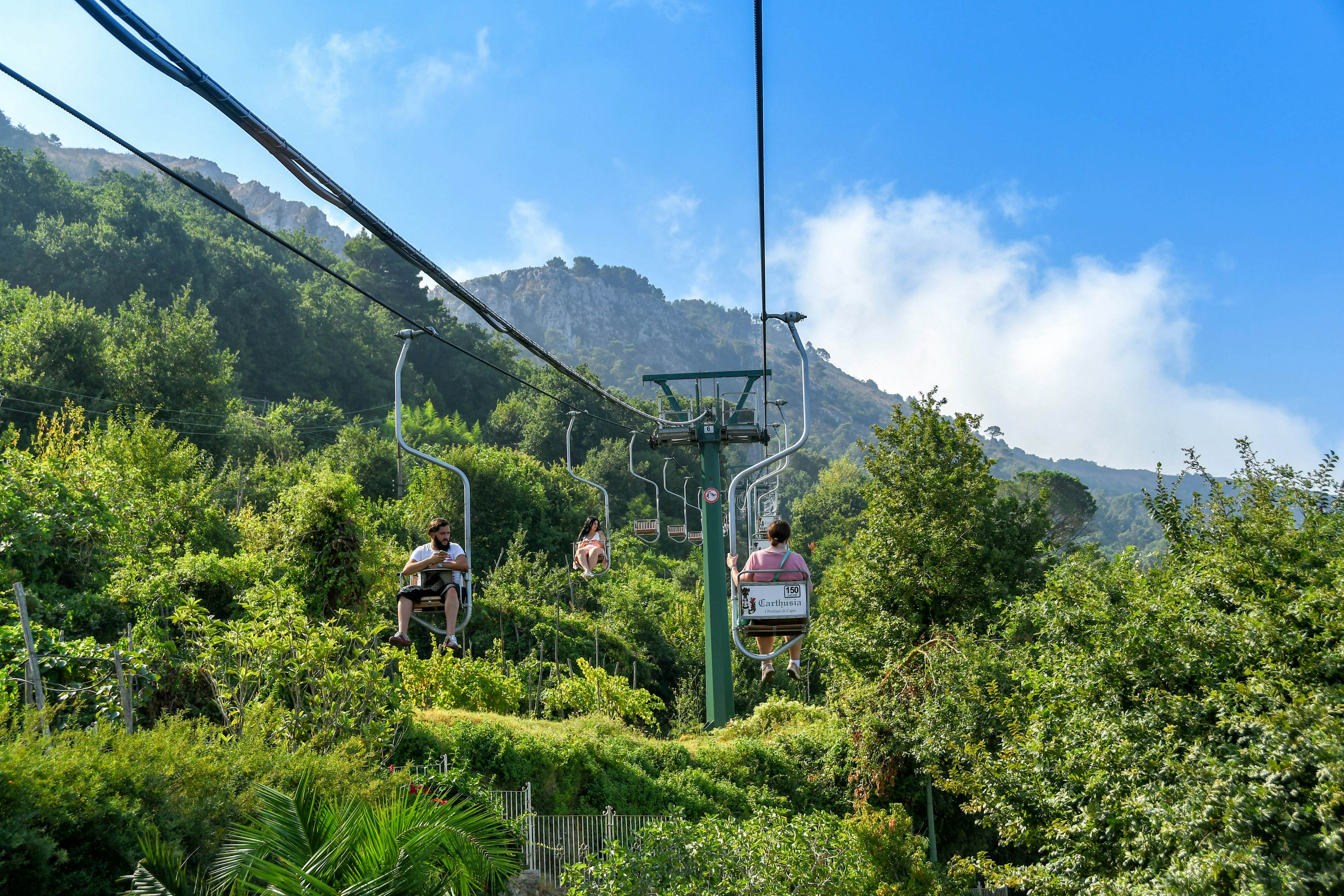
8. Take a funicular and a chairlift in Capri
Capri is the most famous island in the Campanian Archipelago. This rocky isle is a struggle to explore on foot at the height of the summer; transportation is highly encouraged unless you want to stay around the harbor area. If you have more than a couple of hours to spend in Capri, you should explore it.
You can hop on a public bus or take a private taxi, but the best way to get to Capri’s piazzetta (small square) is by taking the small-but-perfectly-formed red funicular right from Marina Grande (the port). The ride uphill only lasts four minutes and provides visitors with a much more scenic route than the bus, traveling above private houses, small farms and prosperous lemon trees. Tickets cost €2.20 per person (the bus is €2.40), and the funicular leaves every 15 minutes.
In Anacapri, the quieter but still beautiful town on the other side of the island, you can hop onto a chairlift to get to the top of Monte Solaro, 589m (1932ft) above the shore. The journey lasts 12 minutes and is more soothing than you might anticipate. Even if you’re mildly afraid of heights, the view from the destination is worth the experience. From the top, you can see the entirety of Capri and the coast, Sorrento included. The chairlift has different opening times depending on the time of year and costs between €11 and €14.
9. Take the Walk of the Gods to Positano
On the other side of the coast sits the charming village of Positano in the province of Salerno. You’ve probably seen colorful photos of its lively alleys, cafes and umbrella-filled beaches. You can get to Positano by ferry (the easiest way), by car or bus (expect terrible traffic) or on foot. If you’re up for the trek, take the path known as the Walk of the Gods. The starting point is Bomerano, which is famous for fior di latte, a type of mozzarella you can snack on along the way.
The three-hour trek to Positano incorporates breathtaking views of the landscape with the backdrop of the glistening sea. At the hike’s summit, right above Positano, is Montepertuso, a literal hole in the mountain that the legends say was created by the Virgin Mary herself. If you brave the climb, pose for a picture within the hole. Afterward, explore the lovely alleys of Positano and treat yourself to a delicious meal with sea views.
Planning tip: If you time your trek correctly, you can capture the moment when the sun sets on the horizon with the hole as a natural frame.
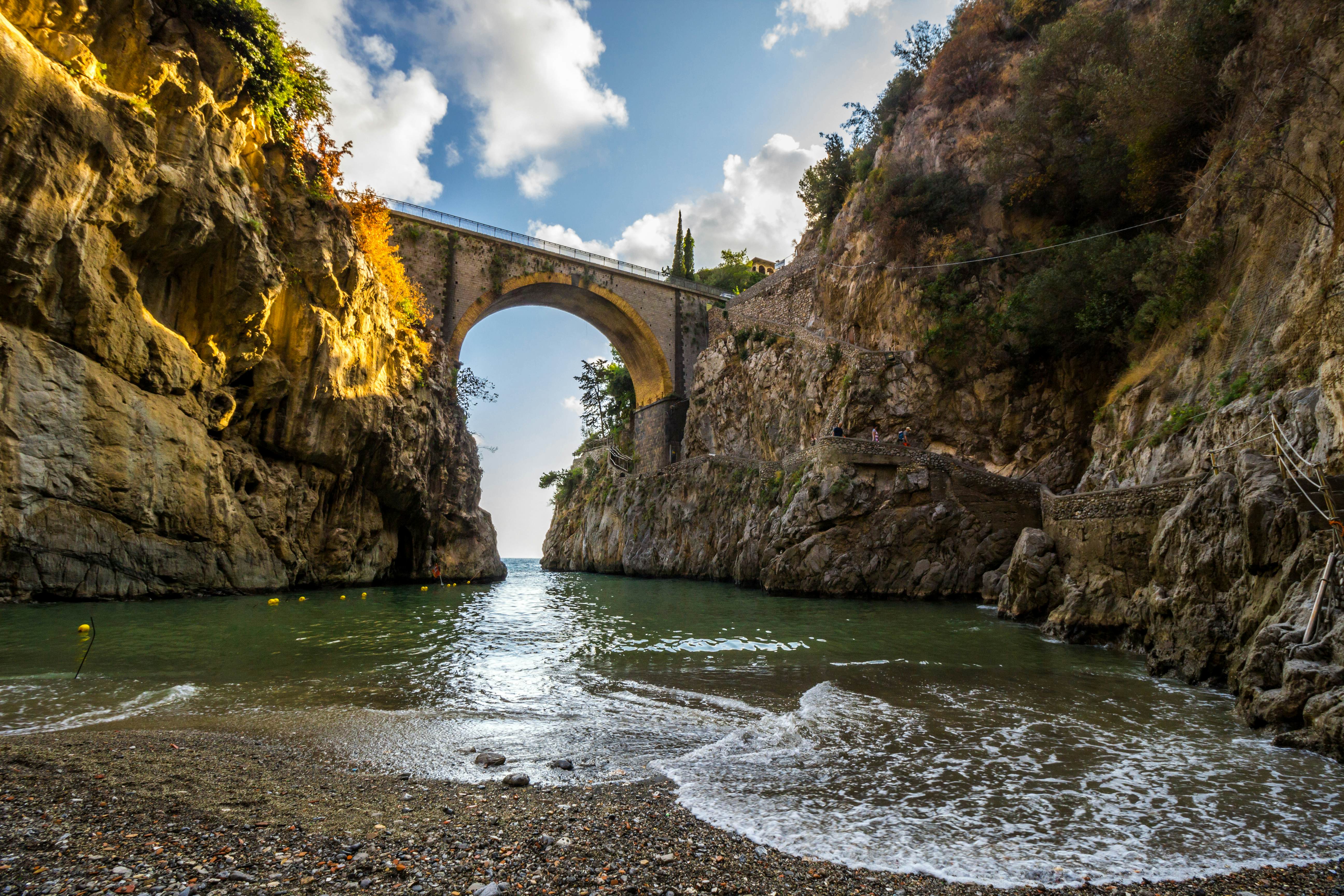
10. Dive from Italy’s only fjord in Furore
The scenic Fiordo di Furore is situated on one of the smallest beaches of the Amalfi Coast - only 25m (82ft) wide - between Praiano and Amalfi. Framed by olive vines and lemon trees, the fjord’s natural beauty makes it a perfect place to unplug and reflect on your trip. However, the beach can get very crowded during the high season, so it’s best to go in the early morning.
The fjord is 28m (91ft) tall and the best spot on the coast for diving lovers. Every year, on a Sunday in July, the fjord hosts an international diving competition called MarMeeting that sees 15 divers compete as they enter the water at 100km/h (62mph). Whether you go for the competition or at a different time of the year, you can reach the fjord by car, though finding a parking spot can be difficult. It’s best to take the Sita bus, get off at the bridge over the fjord and then take the staircase down to the beach.
11. Observe an underwater Nativity at the Emerald Grotto
Whether you make it to the Blue Grotto in Capri or not, you should also visit the splendid Emerald Grotto on the mainland. It’s in Conca dei Marini, an enchanting village between Praiano and Amalfi. The inside of Grotta dello Smeraldo is the closest thing you’ll ever feel to stepping into Oz; its water resembles a mosaic of tiny emeralds shining brightly. Contrasting this green paradise, the cave's walls are covered in semi-monstrous stalactites and stalagmites that sometimes merge halfway.
You can get to the Emerald Grotto by car or bus and take a lift down to the boat platform, or you can travel there by sea. Either way, you will arrive at the grotto by rowboat and be able to view the Nativity scene that’s been at the bottom of the cave since 1964. Tickets to visit the Emerald Grotto are €7; if you arrive by sea, keep in mind that the cost of your boat journey won't include a ticket to the Emerald Grotto itself. You'll need to purchase that separately before boarding a rowboat. Be mindful that the grotto’s opening hours vary depending on the time of year.
Like a typical Italian presepe (Nativity scene), there are statues of the Virgin Mary, St Joseph, baby Jesus, an ox and a donkey. Around Christmas, local scuba divers organize an underwater procession to celebrate Jesus’ birth and pay homage to the Holy Family. For the rest of the year, tourists are forbidden to bathe inside the grotto or touch its walls as it could endanger the grotto’s ecosystem.
12. Explore the Cattedrale di Sant’Andrea in Amalfi
Amalfi’s most famous landmark, the Cattedrale di Sant'Andrea, undoubtedly deserves all the hype it gets. Don’t limit yourself to the almost mandatory picture on the majestic staircase leading to the main structure of the duomo; turn around in the atrium and take one of the piazzetta, including the fountain of St Andrew.
Then, before you enter the cathedral proper (which is free), head to your left and purchase a ticket for €3 that gives you access to the entire complex - you won’t regret it. After the ticket booth, you’ll find yourself in the Chiostro del Paradiso (Paradise Cloister), a small square garden surrounded by a stone colonnade where nature triumphs. You can admire a unique view of the cathedral’s majolica bell tower at its center.
Proceed to the Basilica del Crocefisso (Basilica of the Crucifix; the original 6th-century cathedral) and to the museum. The best part of the experience is down a set of stairs in the Crypt. According to locals, this is the real heart of Amalfi, where the relics of St Andrew are kept. Don’t worry; there’s nothing creepy or sinister about it - it’s a majestic work of art, a temple almost. After taking in all its details, you’re ready to head back upstairs and enter the actual cathedral. Rich in gold and polychrome marble, it’s a prime example of baroque art. Look up at the paneled ceiling, and don’t forget to walk by all the side chapels.
13. Hand-make paper in Amalfi’s paper museum
At a former paper mill turned museum, Museo della Carta, you can learn how paper was made nearly a millennium ago and try your hand at it. Amalfi is the oldest of the Maritime Republics, mighty seaports that dominated trade in the Mediterranean during the Middle Ages. Paper was invented in China, but Amalfi’s network was so vast - through its colonies and partners in the Middle East - that its ships brought paper and the art of its making to Europe. At the museum, you can see the original machinery, witness the authentic process and re-enact it.
If you’re worried about the waste of resources, rest assured that Amalfi’s Museo della Carta promotes recycling, fights paper waste and reuses all materials. The museum offers guided tours and workshops every day, and prices vary depending on the experience you choose. A standard ticket for an adult is €4.50 and €3 for kids under 12.
14. Revel in the quiet of Italy’s smallest town, Atrani
Leave your car in Amalfi and visit an enchanting place that flies under the radar of most tourists - the smallest municipality in Italy. Today, Atrani’s surface covers around 0.2 sq km (0.07 sq miles); you can easily walk the length of it and back while enjoying the breeze. Walk there or take the Sita bus from Amalfi.
Once upon a time, Atrani was a considerable power and a significant ally to the Republic of Amalfi. You can still find traces of the city’s ancient origins in its architecture. It’s impossible to get lost in the town’s alleys and characteristic scalinatelle (stairways), so travel without a map and let Atrani surprise you. You’ll stumble upon churches that have stood here for almost a thousand years, like the beautiful San Salvatore de Birecto and Santa Maria Penitente.
After spending a day in Amalfi, Atrani is the perfect place to escape the chaos while still enjoying the same otherworldly natural beauty of the coast. Or you may come here to enjoy a quieter lunch in the piazzetta. Sit at a cafe or restaurant in the main square and order a lemon granita or some seafood while looking out on the blue horizon to recharge.
Planning tip: If you’re traveling with children, Atrani’s beach is a lovely alternative to Amalfi’s crowded seaside; it may only be 130m (426ft) long, but it’s a perfect sandy escape for families.
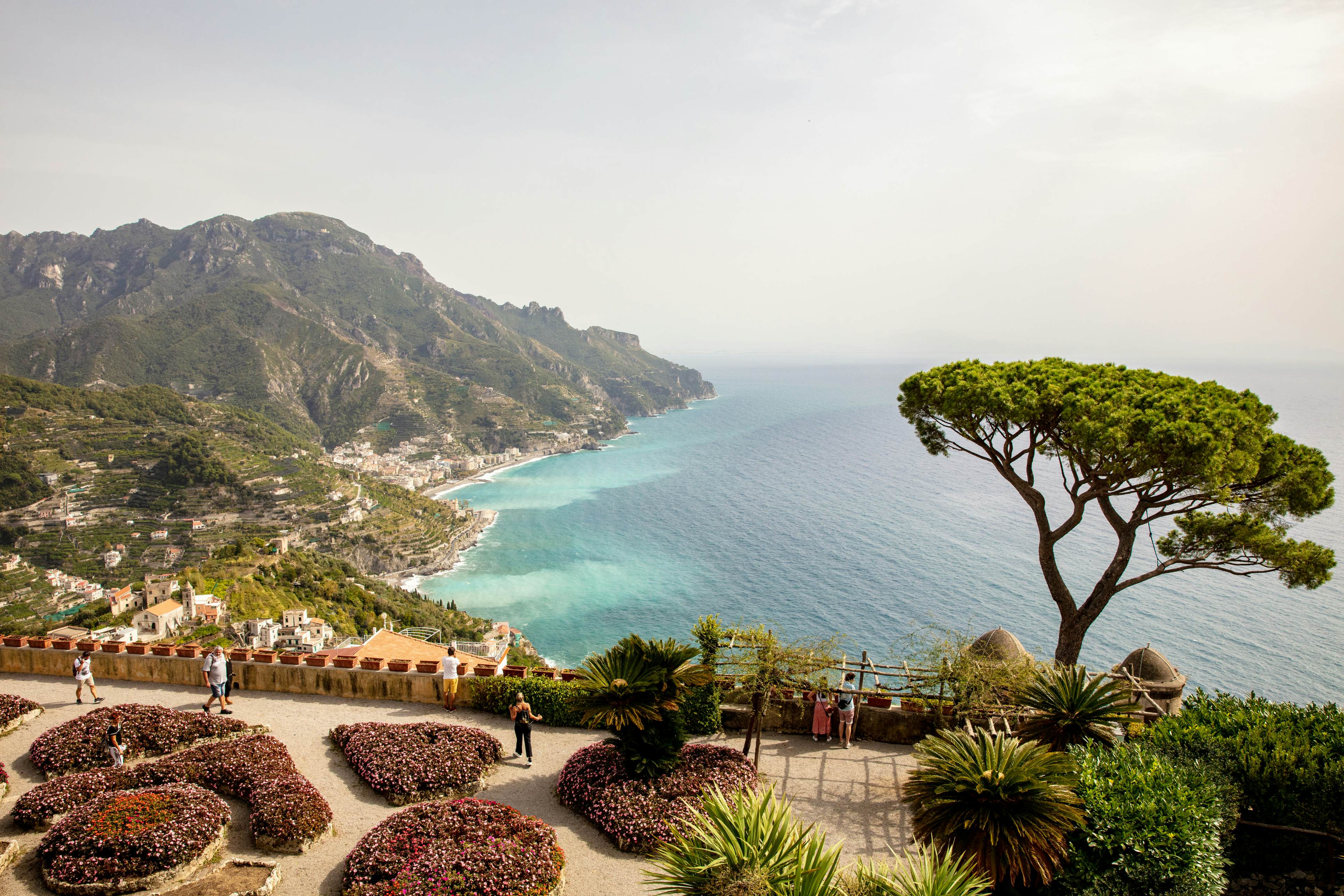
15. Get lost in the beautiful villas and parks of Ravello
Ravello is one of the few towns on the Amalfi Coast that doesn’t directly touch the sea. Built on the hill above Amalfi, Minori and Maiori, Ravello dominates the bay and has a breathtaking sea view from its high altitude. The town is walkable; cars are not allowed in the center, but they will take you up the hill just outside Piazza Duomo. From there, you can explore the various villas and palaces with gardens - the vistas will leave you speechless.
Ravello is dubbed the City of Music and annually hosts an international music festival in the charming Villa Rufolo. When you visit, pay special attention to the Garden of Klingsor - it inspired composer Richard Wagner to write Parsifal following a trip there in 1880.
If you want to feel like you can simultaneously touch the sea and the sky with your fingertips, visit the splendid Villa Cimbrone, 10 minutes and a maze of alleys away from the main square. Explore the gardens and linger on the aptly named Infinity Belvedere, probably the most beautiful terrace on the whole coast, adorned by marble busts. Don’t miss Villa Cimbrone’s many semi-hidden inscriptions, the various temples, the cloister and the crypt.
Many of your favorite writers, celebrities and public figures have sought refuge and solace here or found inspiration for their masterpieces, such as Greta Garbo eloping with her lover, and Virginia Woolf writing her next novel.
16. Walk the Lemon Way from Maiori to Minori
There is a path on the Amalfi Coast named il sentiero dei limoni (the Lemon Way), where you can walk through miles of lemon orchards and take in their heavenly scent. It’s a panoramic walk between Maiori and Minori, once the only road connecting the two towns, where the variant of lemon called sfusato grows. You can start the path in Maiori and walk back towards Minori for 2.5km (1.5 miles) of easy-level hiking: two hours of ancient, picturesque stairs, slopes among lemon trees and the occasional house. If you need some refreshment, stop at a farm along the way for a taste of sfusato.
The lemon path is accessible year-round - the sfusato is in perennial bloom - but it’s especially beautiful in spring and summer when you can witness the farmers picking hundreds of lemons. Picture what it was like in ancient times when the (women) farmers would carry their charges of lemons on their backs down to the bay to be shipped to all of Europe.
Planning tip: Wear comfortable shoes as the pavement can become slippery, and avoid going when it’s raining. In high summer, the path doesn’t provide much shade - it’s best to walk it early in the morning or as the sun sets.
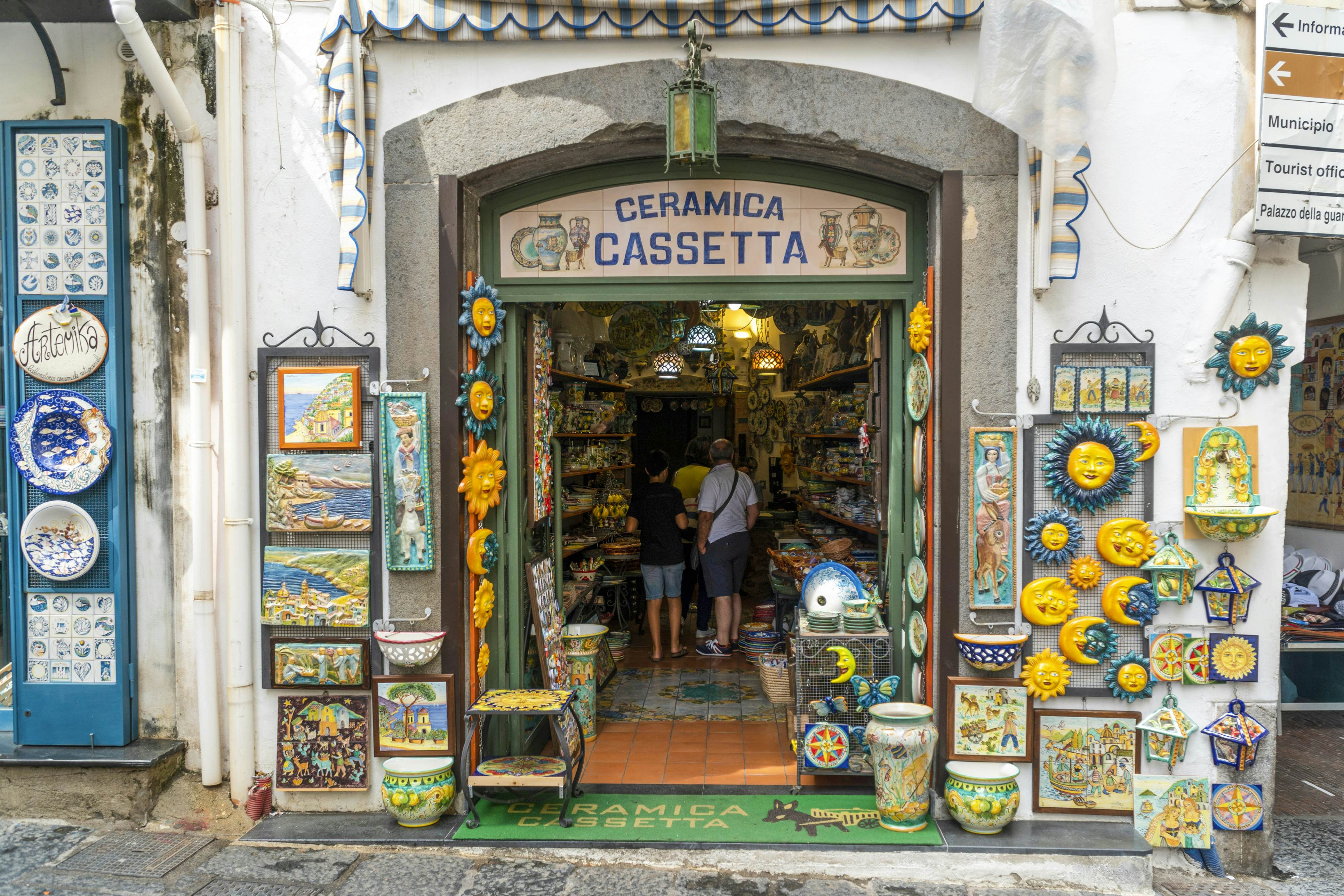
17. Shop for artistic ceramics in Vietri
Vietri Sul Mare is the last town on the Amalfi Coast at its southernmost border. For centuries, Vietri’s economy has been based on the production of pottery. An ancient craft tradition, ceramica vietrese has unique and recognizable patterns adorned with bright colors - usually blue, yellow and red - and often geometric or natural designs.
You’ll see them just about anywhere; any household object you can imagine is handmade with colorful ceramic in Vietri. Throughout Italy, if you wanted to buy elegant tiles, a fancy set of plates or beautiful ornamental objects, you would get Vietrese pottery.
The inhabitants of Vietri have been ceramic experts since at least the 5th century, when they would sell their pottery to the Etruscans. It was only in the Middle Ages, around 1200 CE, that ceramica vietrese became a valuable and popular commodity exported throughout the Mediterranean. If you’ve been to Sicily, you might notice they have similar pottery traditions to Vietri. For a unique view of Salerno and the Amalfi Coast, visit Vietri’s colorful Villa Comunale and explore the historical center of the town.
The town itself is a work of art, decorated with ceramic and majolica designs on its walls, steps and railings. Most of the items are handmade and unique. Ask a local artist to explain why there are so many asinelli or ciucciarielli, the popular tiny statues of donkeys sold in every store. They will proudly answer all your questions: these businesses have been passed on from generation to generation in a local tradition that will hopefully never die.
Link nội dung: https://studyenglish.edu.vn/amalfi-coast-a59935.html